Is the eggplant brown inside? Looking for a reason
Eggplant has several names. One of them is dark-fruited nightshade. His closest relatives are tomatoes and potatoes. Their flowers are most similar. The popular name is blue, according to the color of the fruit. They call him badrijan in translation from Persian.
In southern countries, the Middle East, India and South Asia, it grows wild as a perennial plant. But due to the fact that eggplant does not tolerate a drop in temperature below 0 ° C, in our area it can only be grown as an annual. Eggplants began to be cultivated in Europe in the 19th century.
Content:
- Description of the vegetable
- Why is the eggplant brown inside?
- Diseases of eggplant
- Useful properties of a vegetable
- Growing seedlings
- Transplanting seedlings into the ground
- Eggplant care
Description of the vegetable
Some sources claim that the bushes eggplant can grow up to one and a half meters. But usually their height ranges from 40 to 70 cm. The stem is branched, light green, slightly rough. The leaves are large, oval, solid, with curved edges, covered with a hard, sometimes even prickly down. The leaves are green, in some varieties with a purple tint. The flowers are purple, rather large, 3-4 cm in diameter. The stamens are large, yellow in color, tightly adjacent to each other. They can be arranged one at a time or in inflorescences up to 7 pieces.
Eggplant blooms almost all summer. In place of the flower, a fruit-berry is formed. Depending on the variety, it can be round, pear-shaped, or cylindrical. The peel of the fruit suitable for consumption is smooth, white, green, dark or light purple in color. The fruit is usually 8-10 cm wide, 20-30 cm long, but it can be much larger. The weight of such specimens can reach 1 kg.
Purple-fruited eggplant varieties:
- Robin Hood is a 1.5 m high early fruiting bush. Fruits are small, about 300 g.
- Bourgeois F1 is an early hybrid with flat fruits weighing up to 0.5 kg.
- Marzipan, which is distinguished by its high taste.
- Chernomor is a medium-ripening variety with cylindrical fruits weighing 300 g each and white pulp.
- The bovine heart is a hybrid with purple round fruits.
- Violet Miracle is an early variety with cylindrical fruits weighing 120 g.
The varieties with white fruits do not contain the bitterness common to purple fruits:
- Swan
- Pelican
- Iceberg.
In addition, there are varieties with green fruits (Emerald, "Green"), and orange "Golden eggs". Varieties with red berries are grown as decorative varieties.
Why is the eggplant brown inside?
If the eggplant fruits are not picked in time, they will gradually take on a grayish or brown color. The pulp will become tough and tasteless, and will turn brown.
Such fruits contain solanine, which is harmful to the body. They are not eaten. But from them you can choose seeds, small, flattened, brown. Collection time is the end of summer.
Diseases of eggplant
All eggplant diseases can be divided into:
- Fungal
- Bacterial
- Viral
Fungal include late blight, black leg, white, gray and dry rot, fusarium, cercospora, anthracnose. You can cure them or protect them from disease with the help fungicides (Fitosporin).
How diseases manifest themselves:
- Black leg damages seedlings with strong moisture, late blight damages adult plants.White spots appear on the leaves, brown spots on the fruits. You can fight with the help of copper-containing drugs, Quadris, Antracol. The waiting period after processing is 10 days.
- White rot begins to attack the eggplant bush from the root. The fungi then sneak into the stem, making it soft. Soon the leaves darken and rot, and then the fruits.
- Gray mold usually penetrates through various cracks and injuries. Most often this applies to late varieties and fruits.
- Anthracnose can be recognized by the brown spots on the fruit, which quickly merge, covering a large area. Cracks may appear. Better to fight with HOM.
Viral (various mosaics, phytoplasmosis). Leaves become stained, fruits become small and ugly. Such diseases are not treated, but insecticides are used to prevent them - Aktara, Confidor.
Bacterial (bacterial spotting). The fruits become covered with watery spots, in the place of which ulcers are formed, the leaves - with black dots. Sick eggplants are destroyed.
Most diseases are associated with improper conditions of detention: low temperature or its sharp change, high humidity.
Violation crop rotation also leads to an increase in the incidence. This is facilitated by the thickening of the plantings and the presence of weeds on them. Treating eggplant diseases is much more difficult than preventing them. Therefore, a lot of attention must be paid to the prevention of diseases.
Useful properties of a vegetable
Of all the parts of the plant, only fruits are used for food. They are appreciated for their high taste and a large amount of nutrients. These are potassium (more than 200 mg per 100 g of product), phosphorus (30 mg per 100 g). Among the trace elements, most of all are aluminum, iron, zinc. Blue fruits have a large amount of vitamins, especially group B.
Eggplants are good for all elderly people with heart disease, those with impaired kidney and liver function.
Unlike tomatoes, they can and should be consumed for gout. Foods made directly from fresh eggplants are more beneficial. They help regulate the body's water-salt balance. The amount of nutrients in canned eggplants is much less.
Caloric content of 100 g of the product is 24 kcal. Therefore, eggplants contribute to weight loss. The presence of a large amount of fiber in them helps to regulate digestion processes, get rid of constipation.
Growing seedlings
Seed preparation and growing of seedlings eggplant start in March. On the day of planting, its age should be at least 2 months. The soil is harvested in the fall or bought in a store. It should be light and nutritious, breathable well. They do not take it on the site where the nightshade used to grow. Pathogens of this species have probably survived there, which can destroy young eggplants.
Features of growing seedlings:
- A quarter of a portion of humus and fertilizer are added to the land taken from the garden. But first her disinfectby spilling boiling water or baking in the oven.
- The acidic reaction of the soil must be neutral. If it is acidic, it is lime.
- It is better to take fresh seeds, harvested last year. First, they are prepared by heating them for several hours to 25 ° C.
- Then it is disinfected in a solution of potassium permanganate and immersed in a solution of a growth stimulator.
- Processed seeds can be laid out on damp gauze and germinated for several days. Then they are sown, sprinkling with a small, 0.5 cm, layer of soil. The temperature is maintained at 22-25 ° C.
- Seeds begin to germinate on the tenth day after sowing. After most of them have risen, the temperature is slightly reduced so that the seedlings do not stretch out.
You can place the seeds in trays or individual pots, with several seeds each. In the latter case, weaker plants can be pulled out or transplanted into another container. This process is called diving. As a result, the root system of young plants expands in breadth, which improves their nutrition.
If the plantings are slightly affected by a black leg, diseased plants with a clod of earth are removed. If there are a lot of infected seedlings, discard them completely.
Transplanting seedlings into the ground
The eggplant growing area should be sunny, protected from drafts. Excess moisture should not accumulate there, so that root system did not rot. The soil should also be nutritious, light, good air flow to the roots of plants. The predecessors of eggplant should be cabbage, carrot, beet... Seedlings are planted in rows at a distance of 40 cm from each other. The more space there is between the plants, the less they will be attacked by fungal plants.
Before planting, young eggplants should have at least five leaves and several buds. A couple of hours before planting, the plants are watered abundantly so that the root system is not damaged. Carefully transfer them to the prepared wells, pour over with warm water.
If there is a threat of defeat by the Colorado potato beetle, dilute 2 g of Aktara insecticide in a liter of water and keep the root system for 2 hours.
This will protect the eggplant for several months. Eggplants are not very fond of transplanting, therefore, after planting, it is advisable to shade them. You can mulch the area with cut grass. Young plants respond well to watering, which they spend at least a few days.
Eggplant care
The soil in the aisles must be constantly loosened, removing weeds. This procedure improves its breathability, increases plant immunity. Hilling improves the resistance of the bushes. Tall plants need to be tied to supports. In regions where eggplants are susceptible to the invasion of the Colorado potato beetle, it is recommended to wear tall plastic jars on them, cut off from both sides, or to protect the area with slippery plastic wrap. The same film, but stretched over the night over the plants, will protect them from frost in the middle lane. It is better to grow varieties that are resistant to lower temperatures, for example, "King of the North".
Eggplants love abundant watering.
In dry soil, the fruits are bitter and tasteless. Water is brought in in the evening, after it warms up in the sun. After watering, you can apply fertilizer. This is done three times per season. Add solution chicken droppings or mullein... To do this, a kilogram of dry fertilizer is diluted in 10 liters of water, infused for 10 days, then diluted in water in a ratio of 1/10.
Eggplant bushes can be formed by changing the weight of the fruit, their number and ripening time. If, after the formation of several fruits, the side branches are removed, they will ripen much earlier than on an uncut bush. Their weight will be greater.
More information can be found in the video:



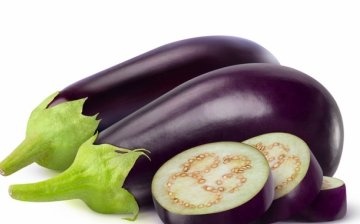
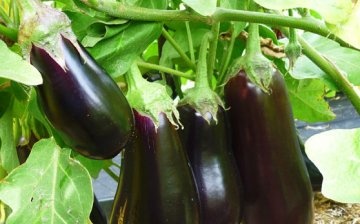

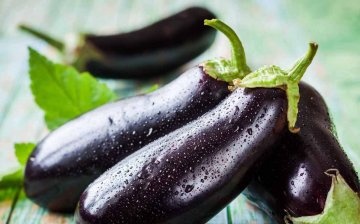

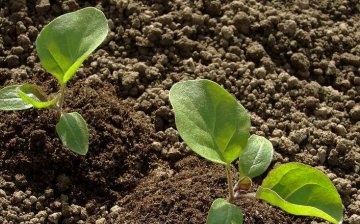
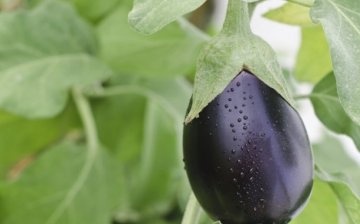







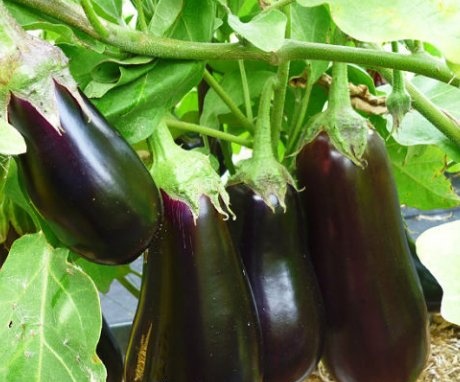

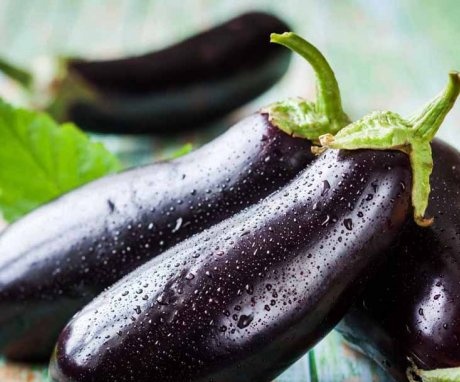

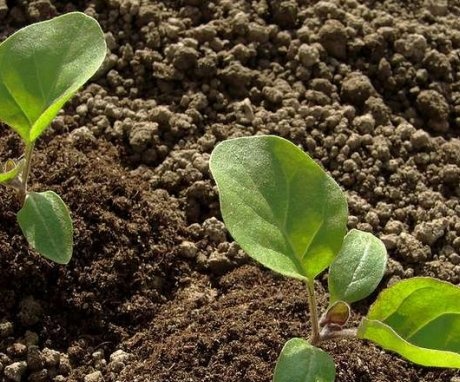
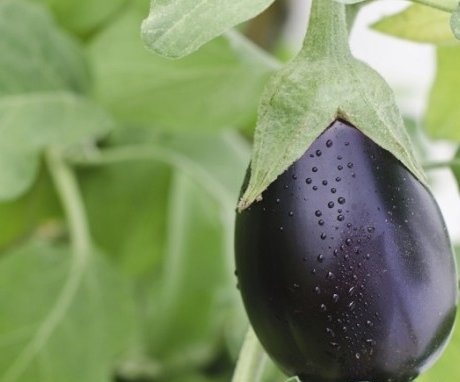
Last year, eggplants were struck by gray rot. I had to collect the entire "crop" of eggplant and process the soil in the greenhouse with a solution of copper sulfate. We burned all the plant waste. This year everything was already great, a huge amount of eggplant has grown.
I still haven't come across such sick eggplants with a changed color inside, but last year some fruits were with some kind of wooden inclusions inside, like thin toothpicks. I don’t know what this disease is.
Black leg also affects tomatoes, all this arises from improper planting, it is important to observe all the necessary conditions so that eggplants and tomatoes grow healthy and not damaged by the parasite.